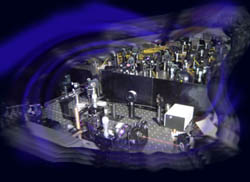
By making good use of certain quantum physics properties such as entanglement, teleportation and superposition, a quantum computer has the potential to be much more powerful than a classical computer of the same size. Although Quantum-mechanical entanglement of three or four particles has been achieved experimentally, and has been used to demonstrate the extreme contradiction between quantum mechanics and local realism, the realization of five-particle entanglement, until recently, remains an experimental challenge.
As reported in the July 1 issue of
Nature, Prof. Jian-Wei Pan and his colleagues at the University of Science and Technology of China in Hefei have been succeeded for the first time in the world in entangling five photons and demonstrating a process called "open-destination teleportation".
The results are spoken highly in the international community of physics as a major breakthrough in efforts to exploit the laws of quantum mechanics in quantum information processing.
With the support from the national knowledge innovation program piloted by CAS, national basic research priority program and National Natural Science Foundation of China, the researchers began their work by producing a high intensity and ultra-stable source of entangled photons. Next they used two entangled pairs of photons to generate a four-photon entangled state, which they then combined with a single-photon state. After three-year hard work, they are finally able to produce a five-photon entangled state by detecting the coincidence of five photons.
Although compared to the previous experiments, said Prof. Pan, our experimental demonstration might seem to be only a modest step forward, the implications are profound.
First, the experiment has demonstrated the ability to manipulate five-particle entanglement, which is the threshold number of qubits required for universal error correction. Second, the realization of open-destination teleportation opens up new possibilities for distributed quantum information processing. Last, the techniques developed in the present experiment enable experimental investigations of a number of quantum protocols.
The research team plans to use their five-photon set-up to demonstrate "bit-flip error rejection" for quantum communication and to make a non-destructive controlled-NOT gate for quantum computation.





